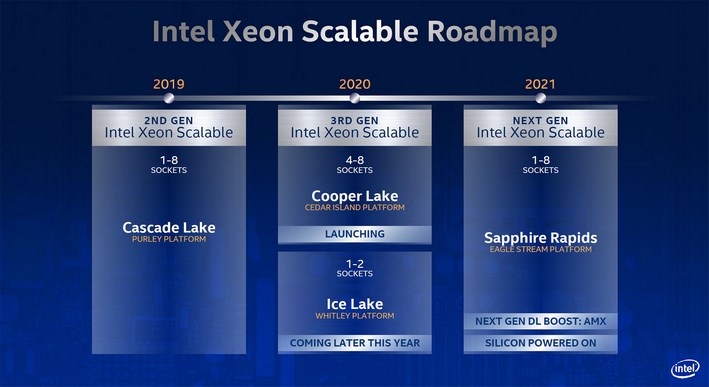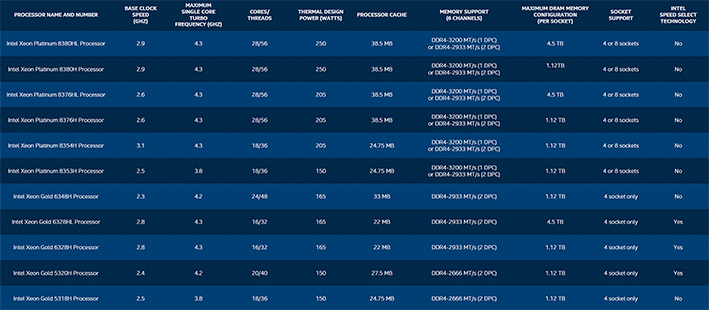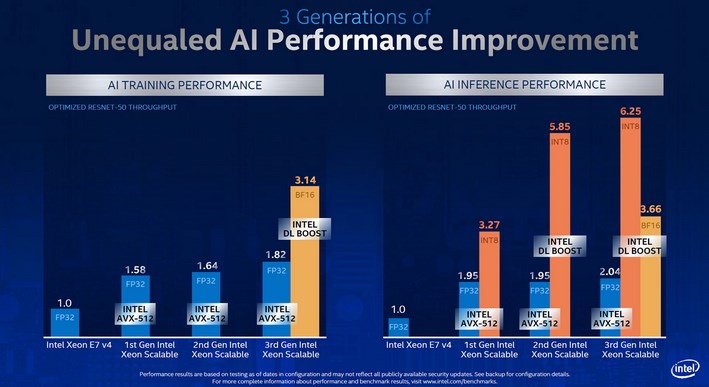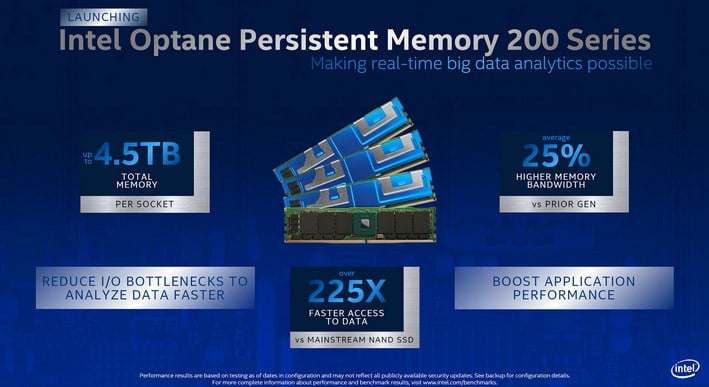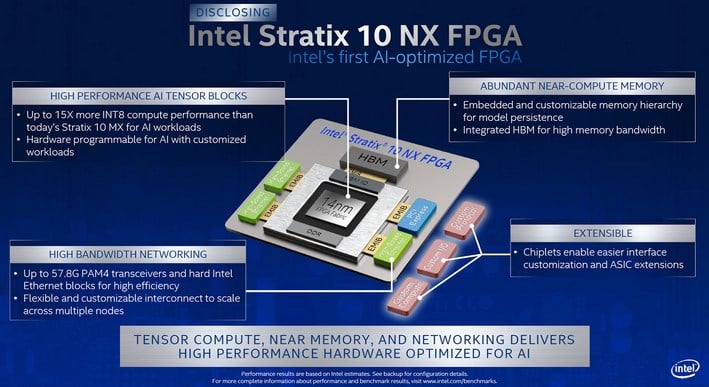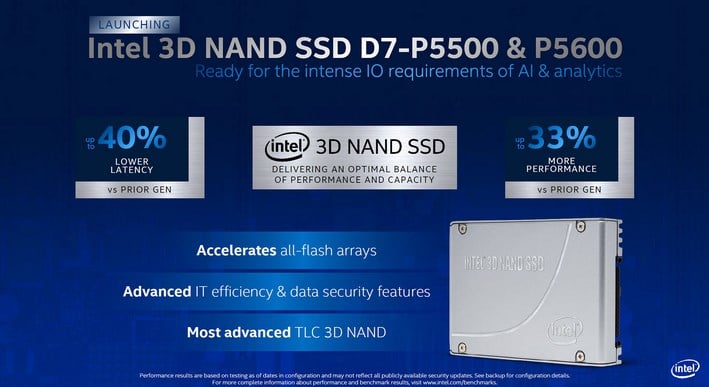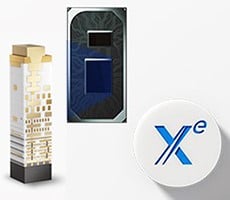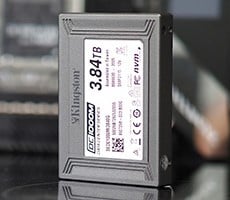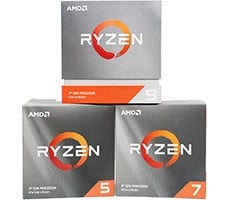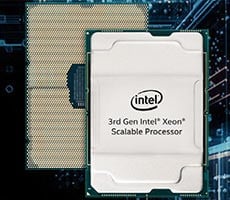Intel Unleashes New 3rd Gen Xeons, Optane Memory, And FPGAs To Accelerate AI And Analytics
Intel's New Xeon Processors, Memory, Storage and FPGA Solutions For AI and Analytics
The Intel Data Center Group (DCG) unveiled a plethora of new products today targeting AI and big data analytics workloads, including 3rd Generation Xeon Scalable Processors, 200 Series Optane Persistent Memory, AI-optimized Stratix 10 NX FPGAs, and faster 3D NAND-based solid state drives.
Over the last few years, Intel has taken a multi-pronged approach to its data center products portfolio. In addition to advancing its processor platforms to improve compute performance and better accelerate new, emerging workloads, Intel has also focused on bringing data closer to the processor, and granting the processor (and accelerators) faster access to that data. Today’s announcements regarding new processors, memory, FPGAs, and storage are a nod to those plans, and demonstrate Intel’s commitment to advancing the entire data center ecosystem.
New 3rd Gen Intel Xeon Scalable Processors
Intel’s new 3rd Generation Xeon Scalable processors are a mix of existing and new technologies. At their core, these new processors are fundamentally similar to previous-generation parts and are still built on Intel’s 14nm++ process node. Intel has focused on AI acceleration with these new processors, however, and has incorporated support for bfloat16 into the DL Boost instructions. Bfloat16 is a compact numeric format that uses half the bits of FP32, but can achieve comparable model accuracy under the right conditions, with minimal software changes required, according to Intel. It is sort of a middle point between INT8 and FP32.
3rd Generation Xeon Scalable processors are codenamed “Cooper Lake”. The new line-up consists of 11 processors, designed for 4 and 8 socket systems (Ice Lake-based processors coming a little later will target more common 1 and 2 socket platforms). Core counts range from 16 (32T) to 28 (56T), with up to 38.5MB of cache, and base / max single-core boost clocks ranging from 2.3GHz on up to 4.3GHz. These new Intel processors are not drop-in replacements from previous-gen parts, however. 3rd Generation Xeon Scalable processors require a new platform (Cedar Island) and LGA4189 socket.
Since the CPU cores are essentially unchanged, performance with traditional workloads don’t change much versus Cascade Lake. But the updated DL Boost technology does have major performance implications according to Intel. For both Training and Inference AI workloads, DL Boost (leveraging INT8 or bfloat16) shows >3x to >6x improvements in throughput.
Intel Optane Persistent Memory 200 Series
Intel also announced the second-gen Optane persistent memory 200 series. Intel Optane DC Persistent Memory leverages 3D XPoint memory technology, which is a non-volatile memory type that offers significantly better performance than NAND flash memory, but with DRAM-like access times. 3D XPoint also offers higher endurance than NAND flash memory, but with similar capability to scale in density. When it was first introduced, Intel (and partner Micron) claimed that 3D XPoint had the capability to be 1000x faster than NAND, with 1000x the endurance, but with 10x the density potential of DRAM. With the Optane persistent memory 200 series, Intel can offer customers up to 4.5TB of memory per socket now.Optane Persistent Memory 200 Series products offer and average of 25% more memory bandwidth than the previous generation and are available with 12-15 Watt TDPs, in capacities up to 512 GB. Intel also note that the Optane Persistent Memory 200 Series is compatible with the existing software ecosystem introduced with original Optane persistent memory products.
AI-Optimized Stratix 10 FPGAs
Also being announced today are new Intel Stratix 10 NX FPGAs. Intel states the Stratix 10 NX is the company’s first AI-optimized FPGA.The Stratix 10 NX consists of 14nm FPGA fabric, with high-bandwidth networking, HBM, and a PCI Express interface, linked to the fabric via Intel’s EMIB technology. The Stratix 10 NX also incorporates new AI-optimized arithmetic blocks Intel is calling AI Tensor Blocks, which contain dense arrays of lower-precision multipliers optimized for the math required for many AI models. Intel is claiming up to 15X better INT8 performance versus the previous-gen Stratix 10 MX.
New Intel 3D NAND SSDs
In addition to the new processors, memory, and FPGAs, Intel introduced a couple of new families of data center SSDs as well, the Intel SSD D7-P5500 and P5600. The Intel SSD D7-P5500 and P5600 feature Intel’s latest 96-layer triple-level cell (TLC) 3D NAND and an all-new, low-latency PCIe controller. According to Intel, these new drives offer up to 40% lower latency and up to 33% higher throughput then previous-generation drives.
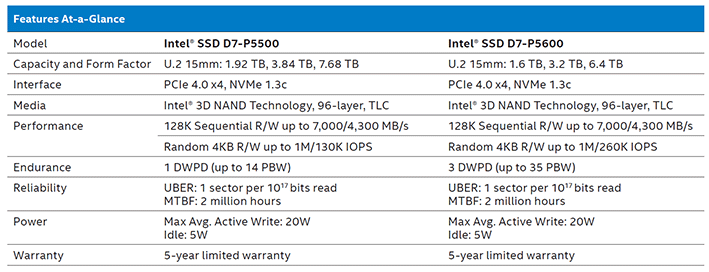
The SSD D7-P5500 and P5600 series will be available in multiple capacities (up to 7.68TB) and use the U.2 form factor. Their specifications how lofty 7GB/s read speeds, with writes north of 4GB/s. Also note that these drives support the NVMe 1.3c spec, and have PCIe Express 4.0 interfaces.
According to Intel, 3rd Gen Xeon Scalable processors, Optane Persistent Memory 200 series, and SSD D7-P5500 and P5600 3D NAND SSDs are shipping to customers now. The Intel Stratix 10 NX FPGA is expected to be available later in the second half of this year, however. All told, although they’re not technically all new, Intel’s 3rd generation Xeon Scalable processors should offer significantly better performance with AI workloads that will benefit with their enhanced DL Boost functionality. The rest of the ecosystem updates bolster what is already the dominant data center platform and better position Intel as the company readies its next-generation Sapphire Rapids offering.

